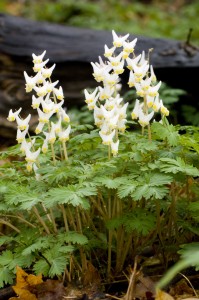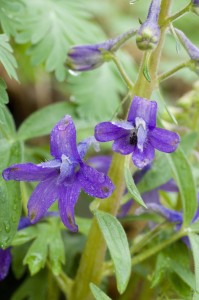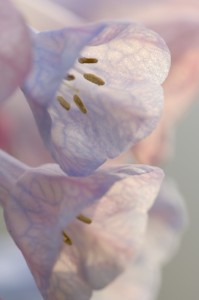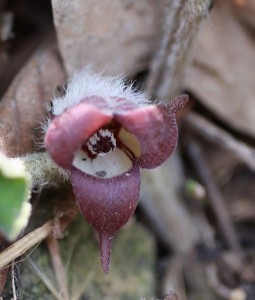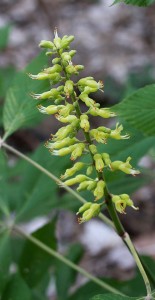Spring Wildflower Walk Is Also a Path into History
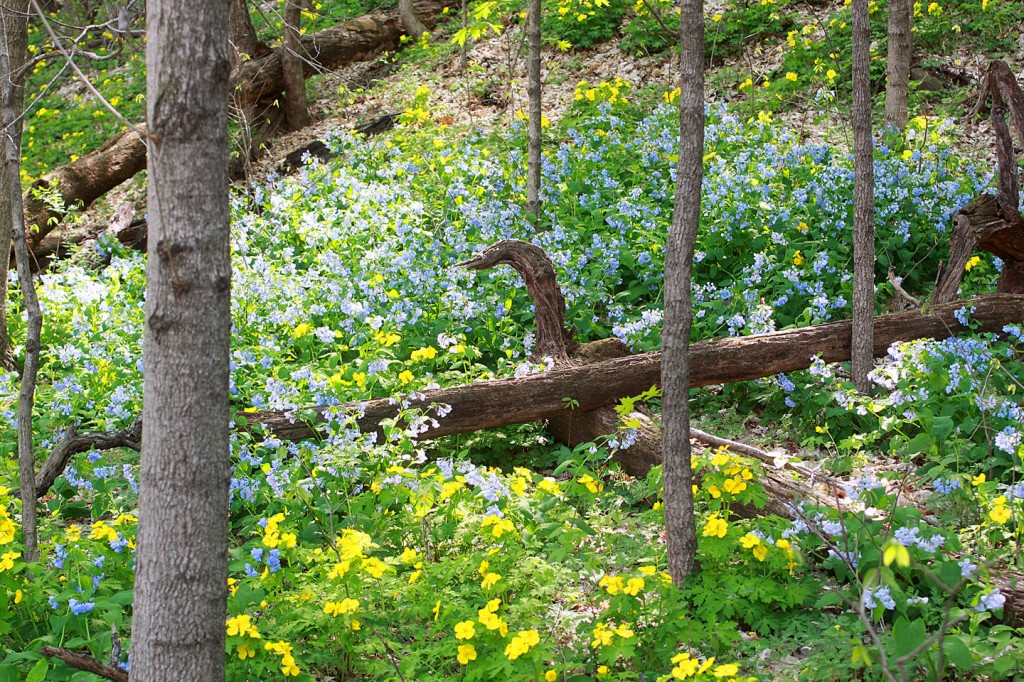
Celandine poppies and Virginia bluebells along the Johnson Trail. Photo courtesy Paul Feldker, Clifftop.
A springtime wildflower hike on the flat and easy Johnson Trail at Valmeyer’s Salt Lick Point Land and Water Reserve is both a walk in the footprints of the past and a promise of a protected future.
Native Americans preceded our footsteps along the trail for at least three or four millennia. Archeological evidence at Salt Lick Point confirms ceremonial burial mounds along the blufftops above the cliff face. A seasonal Amerindian forest product manufactory has been documented on the site of new-town Valmeyer. Native American rock paintings exist within a few miles of the trail. And, adjacent to the Reserve ancient floodplain saltpans, from which Salt Lick derived its name, provided invaluable resources to generations of Native Americans and early Euro-American settlers.
A thousand years ago, the Mississippian Native American culture reached its acme, with the semi-agriculturist, permanent settlement of the Cahokia Moundbuilders and neighboring clans, including Cahokia and Michagamea settlements in Monroe County. The Mississippian peoples took part in a vast inter-tribal trade economy that stretched far and wide. Local archeological evidence of shells and beads from the Atlantic Seaboard and Florida and stone tools and pottery chards from the Western and Southwestern Rockies indicate long-ago flourishing trade networks.
An April wildflower walk along the Johnson trail demonstrates the bountiful cornucopia of woodland resources used by local Native Americans, and later, by early Euro-American settlers, for consumption and trade.
The delicate, fern-like leaves of the unusually shaped, pinkish-flowered Dutchman’s breeches (Dicentra cucullaria) were boiled into an infusion. In our area, this early spring tea was believed to strengthen muscles. Euro-Americans continued use of Dutchman’s breeches tea, but, in their case, believed the drink would help with urinary problems.
Our beautiful early-blooming columbines (Aquilegia canadensis), absolute magnets for early-arriving hummingbirds, also were used for medicinal purposes. A leaf tea was taken for heart trouble, and leaves were crumbled into a wash to ease the irritation and itch of poison ivy exposure. Columbine leaves also were burned as incense.
While most of us now simply admire showy, low-growing bloodroot (Sanquinaria canadensis) and welcome its white blooms as one of the earliest signs of spring, this plant, too, was put to a variety of uses. The roots served as tonics for intestinal disorders and for colds and coughs. More importantly, the roots made a deep red dye. North American Indians shared a remarkable color code system. As a war paint, red meant energy and strength. As a decorative paint for basketry, pottery, and tools, red implied beauty. Bloodroot provided this important color in the palette of life.
The symbolism of color, of course, varies among cultural groups. Native American peoples would have recognized the European’s traditional belief that yellow represents dawn, sunshine and life. Unlike the European tradition, which also links the color yellow with cowardice, Native Americans, perhaps in a more logical continuum, celebrated life-giving yellow as a sign of bravery. Yellow war paint was taken as a signal of the wearer’s intentions to fight to the death. A primary source of rich yellow dye used by Native Americans was produced from the roots of celandine poppies (Stylophorum diphyllum). These gorgeous, large yellow-flowered plants are early spring bloomers that freely share company with Virginia bluebells and dwarf larkspur.
Showy, blue dwarf larkspur (Delphinium tricorne) is at its best in early spring. This plant, too, was a part of the primary color palette used by Native Americans as the flowers produce a sky-blue dye. This color, like the bright aspect of a spring sky, represented confidence and was used as both a war and ceremonial paint. All parts of the plant are poisonous to beasts and mankind; however, Amerindians, early settlers, and Civil War soldiers utilized larkspur leaf juices as an insecticide.
The stunningly beautiful blue flowers of Virginia bluebell (Mertensia virginica), growing in dense colonies, would always draw the eyes of early travelers, and still bring us out to wonder at and wander among their beauty. A leaf infusion of Virginia bluebells was used throughout the continent for the treatment of tuberculosis.
Both blue phlox (Phlox divaricata) and cleft phlox (Phlox bifida), clinging to rocks and ledges, will be blooming in early spring. Native Americans and early Euro-American settlers concocted a phlox plant leaf tea for eczema and as a blood purifier.
Singular trout lilies (Erythronium americanum) can be found here and there in rich woodlands. Wound treatments were made from the juices obtained by crushing leaves of these small yellow nodding-flowered plants. They often grow and bloom compatibly beside the delicate, yellow-flowered pale corydalis (Corydalis flavula). This particular plant was a good trade item, as Native American peoples of the southwestern U.S. devised a corydalis leaf infusion to stimulate melon seed production, a staple of their diets.
Several trees and shrubs will also be flowering in our bluff lands during early spring and all contributed to Amerindian life and economies. Yellow-flowered Spicebush (Lindera benzoin) is among the earliest shrubs to bloom. Spicebush leaves were and still are brewed to make a tea. And its bright red berries formerly were added to flavor meats. Similarly, the red berries of white-flowering Serviceberry (Amelanchier arborea), another early spring bloomer, were used to season stews and soups.
White-flowering bladdernut (Staphylea trifolia) bushes are present in shady, moist areas, and by fall the flowers have transformed into three-sided Chinese-lantern shaped seedpods. Native Americans throughout much of the country opened the pods to collect the seeds for use in ceremonial rattles. A tea of dried bladdernut leaves was also thought useful in the treatment of rheumatism.
Pawpaw (Asimina triloba) trees offer their deep-maroon blooms in a seeming contrast to the dominant whites and yellows of early flowering shrubs. Their inner stem fibers were widely used to weave the strongest ropes, and their September-produced fruits were mashed into corn breads and dried for snacks. It’s a lucky hiker who comes across a good supply of pawpaw’s custard apples for the sweet-tangy fruits are a delicious snack.
Finally, our lovely buckeyes flower
in early spring. In our area, the numerous, yellow-green flowers of Ohio buckeye (Aesculus glabra) and red flowers of the rarer red buckeye (Aesculus pavia) are magnificent to see. As we still do, Native Americans also carried around buckeye nuts for good luck. Since all parts of the plant are extremely poisonous, Native Americans in our area craftily pounded their roots into a powder then spread the powder on waterways to stun fish and make them easier to catch.
A springtime walk along the Johnson Trail – where all these and many other plants show their blooms in early spring – also is a journey through history and a testimony to the Village of Valmeyer’s and the all-volunteer Salt Lick Point Stewardship Committee’s shared conviction that local faces can indeed protect and preserve our great places.
The Salt Lick Point Stewardship Committee, the Illinois Nature Preserves Commission, the Kaskaskia Valley Audubon Society and Clifftop are co-hosting a Spring Wildflower Walk on the Johnson Trail on Saturday, April 12th, from 9 AM until noon. Interpreters will give short presentations and identify flowers at a variety of stops along the flower-strewn area. The walk is free and open to the public and registration is not required. Meet at the Salt Lick Point Land and Water Reserve trailhead parking lot, off of Bluff Road, near the Rock City entrance, in old-town Valmeyer.
CLIFFTOP, a local nonprofit organization, is focused on preserving and protecting area bluff lands.
A version of this article appeared in the 4 April 2014 edition of the Monroe County Independent.
© 2014 all content rights reserved Clifftop NFP
Comments are currently closed.

